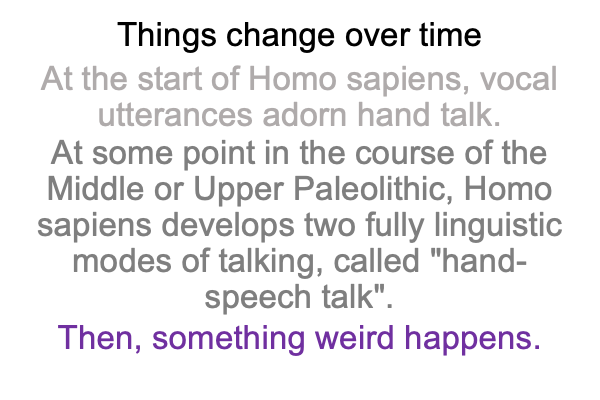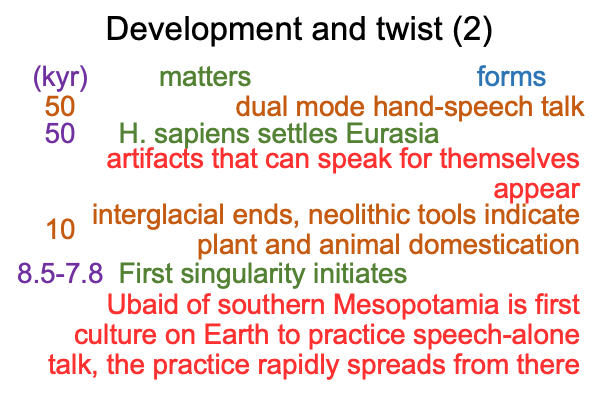0415 In synaesthesia, impressions2a cross modes. Visual stimulates auditory. Auditory triggers visual. What is the sound of an image? What is the image of a sound?
The strange part is that both hand-talk and speech-talk are rapidly decoded by the Wernicke’s region, located around the left temporal lobe, as well as other regions specialized for language.
As speech decouples from hand-talk, the archaeological record blossoms with innovative technologies, symbolic artifacts, and evocative adornments, including spectacular burials.
0416 But, the archaeological record of the Upper Paleolithic gives no indication that something weird is about to happen.
Here is a picture.

0417 By the time that humans in Eurasia are no longer interbreeding with Neanderthals and Denisovans, they practice hand-speech talk as a dual-mode way of talking. Speech is no longer merely an adornment to hand talk. Speech has taken a life of its own.
Humans create artifacts that can speak to their owners.
0418 Julian Jaynes uses the term, “auditory hallucination”.
But, that is not a satisfying label for what the artifact says. The artifact serves as a visual stimulus that triggers cross-modal synaesthesia, or spoken words, that are automatically decoded into a species impressa2a.
0419 Okay, as far as an insight-filled modern psychologist is concerned, that species impressa2a is “an auditory hallucination”.
However, as far as this examination is concerned, the species impressa2a is also the sign-object (SOi) of an interventional sign-relation.
Plus, the left and right hemispheres have specialized regions… phenotypes… that embody the human adaptation into the niche of the interventional sign-relation.
0420 Jaynes associates these specialized regions to the Wernicke’s region (in the left hemisphere) and the corresponding lateral region (in the right hemisphere). Wernicke’s region on the left is specialized to rapidly decoding symbols (whether in the form of hand-talk or speech-talk) in the construction of a species impressa2a. Wernicke’s region on the right is specialized to constellate commitment2c. Commitment2c (SVi) stands for a species impressa2a (SOi) in regards to the normal context of what is happening3a operating on the potential of ‘something’ happening1a (SIi).
0423 As the interglacial ends, around 10kyr, Neolithic tools signal the start of a new stone age. Plant domestication spreads. So does animal domestication. The two productive trends join in the so-called Developed Neolithic. Humans are told to give plants as food to their animals.
Told?
Think “auditory hallucination”.
0424 Here is a picture of the timeline.

0425 Then, something weird happens.
The first singularity begins.
The first singularity is portrayed in many of Razie Mah’s works, including The First Singularity and Its Fairy Tale Trace and An Archaeology of the Fall, available at smashwords and other e-book venues.
0426 But, I am not above repetition.
0427 When the current interglacial begins, the oceans rise as glaciers melt. The rise is so significant that the Persian Gulf fills. Twelve-thousand years ago, the Persian Gulf is a dry valley with a river gorge, home to two late-stone-age hand-speech-talking cultures, one Neolithic dryland farming and stockbreeding on the valley floor and one Mesolithic coast-dwelling and wetland-familiar in the river gorge. The rise of the sea level drives them to the edges of the Persian Gulf. The two hand-speech cultures become one speech-alone talking culture, the Ubaid of southern Mesopotamia.
0428 The linguistic consequences of two independent cultures being forced together is well documented from historical studies. The two languages get picked up willy nilly, without grammar, as a pidgin. Then, the pidgin is routinized in the next few generations, resulting in a fully linguistic creole.
In this case, the original cultures practice hand-speech talk and the resulting creole ends up as speech-alone talk.
At the time the Ubaid forms, it is the only culture in the world practicing speech-alone talk. All contemporaneous cultures engage in hand-speech talk.
In this regard, it is not surprising that the Sumerian language is unrelated to any large family of languages.
0429 But, there is something that is surprising.
0430 The differences in semiotic qualities between hand-speech talk and speech-alone talk account for the subsequent emergence of unconstrained social complexity in southern Mesopotamia.
As already noted, iconic and indexal hand-speech relies on implicit abstraction and serves to maintain the harmony among social circles within a tribe. In other words, hand-talk and hand-speech talk facilitate constrained social complexity. Teams are specialized, not people.
In contrast, purely symbolic speech-alone talk allows explicit abstraction . Speech-alone talk allows anything to be labeled: parts, wholes, individuals, groups, and so forth. This type of labeling encourages both labor and social specialization, as well as technical innovation. Speech-alone talk promotes unconstrained social complexity.
From its inception, the Ubaid of southern Mesopotamia has greater wealth and power, as well as technical superiority, compared to adjacent hand-speech talking cultures.
0431 So what happens next?
Nearby hand-speech talking cultures drop the hand-component of their hand-speech talk and begin to experience marginal increases in wealth and power promoted by the purely symbolic nature of speech-alone talk.
Speech-alone talk spreads from Mesopotamia to the rest of the world on the wings of mimicry.
